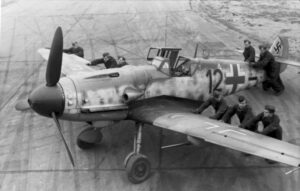

The history of Messerschmitt, one of Germany‘s most renowned aircraft manufacturers, is deeply intertwined with the development of military aviation during the 20th century. Founded by Willy Messerschmitt in 1923, the company initially focused on designing and producing light sports and utility aircraft. However, with the rise of the Nazi regime in Germany and the rearmament efforts leading up to World War II, Messerschmitt shifted its focus to military aircraft production.
From legendary fighters to groundbreaking jet-powered planes, these iconic aircraft represent the epitome of innovation, performance, and historical significance in the world of aviation.
One of Messerschmitt’s most iconic contributions to aviation history was the Bf 109, a single-seat fighter aircraft that became the backbone of the Luftwaffe (German Air Force) during World War II. Introduced in the mid-1930s, the Bf 109 was a highly versatile and formidable fighter plane known for its speed, agility, and firepower. It played a significant role in air battles throughout the war and was widely regarded as one of the best fighter aircraft of its time.
In addition to the Bf 109, Messerschmitt also developed other notable aircraft during World War II, including the Me 110 heavy fighter and the Me 262, the world’s first operational jet-powered fighter aircraft. The Me 262, in particular, represented a significant technological advancement in aviation and showcased Messerschmitt’s pioneering spirit in aircraft design.
Following Germany’s defeat in World War II, Messerschmitt’s production facilities were dismantled, and the company was temporarily banned from manufacturing aircraft. However, in the post-war years, Messerschmitt was reestablished as a civilian aircraft manufacturer, focusing primarily on producing commercial and business aircraft.
Throughout the latter half of the 20th century, Messerschmitt continued to innovate in the field of aviation, developing a range of civilian aircraft and aerospace technologies. In 1968, the company merged with Bölkow and Hamburger Flugzeugbau to form Messerschmitt-Bölkow-Blohm (MBB), which further expanded its capabilities in aerospace engineering and defense technology.
Today, the legacy of Messerschmitt lives on through various companies and organizations that continue to honor its contributions to aviation history. While the name may no longer be associated with aircraft manufacturing, Messerschmitt remains an enduring symbol of innovation, excellence, and technological prowess in the field of aviation. Here are all of the company’s aircraft:

The Messerschmitt Bf 108 was a German single-engine aircraft developed by Bayerische Flugzeugwerke in the 1930s.

The Messerschmitt Me 262 Sturmvogel is a fighter bomber aircraft and the world’s first jet-powered fighter aircraft.

The Messerschmitt Me 209 was a German single-engine racing aircraft designed to break speed records and used as a propaganda tool in WW2.

The Messerschmitt P.1101 was a single-seat jet fighter developed by Messerschmitt for the Third Reich during the Second World War.

The Messerschmitt Me 163 Komet was a German rocket-powered interceptor aircraft primarily used by the Luftwaffe in the 1940s.

The Messerschmitt Bf 110 was a German twin-engine destroyer fighter-bomber developed in Nazi Germany in the 1930s and used in WW2.

The Messerschmitt Me 262 Schwalbe was a German fighter designed by Messerschmitt and used during the Second World War.

The Messerschmitt Me 410 Hornisse was a German heavy fighter and bomber the Luftwaffe used during World War II.

The Hispano Aviación HA-1112 is a license-built version of the Messerschmitt Bf 109G-2 developed in Spain during and after World War II.

The Messerschmitt Bf 109 is a German fighter aircraft and the backbone of the Luftwaffe’s force during World War II.